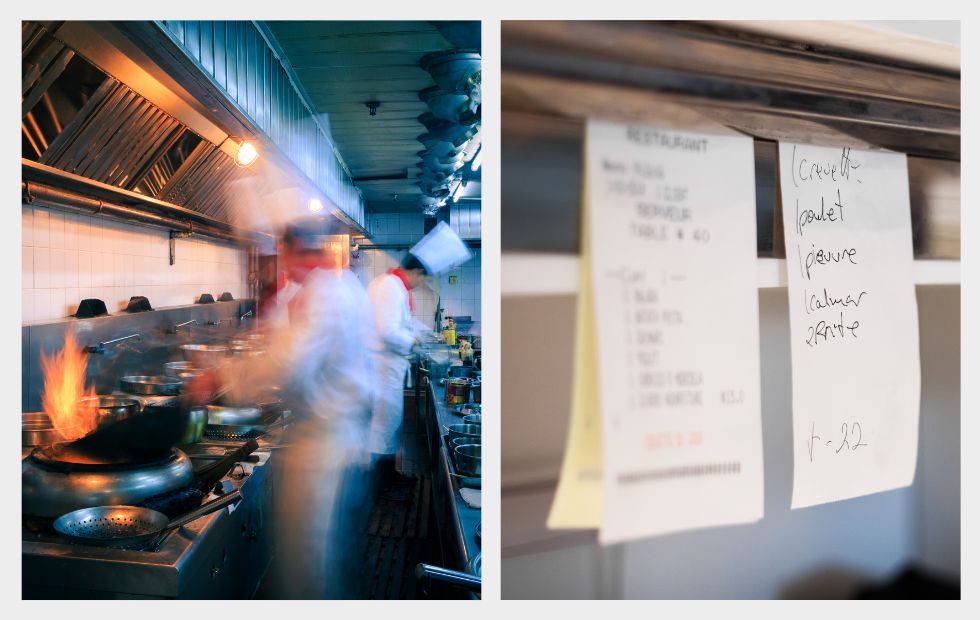If one thing is certain about language, it’s that it changes. As people develop new ways of expressing themselves, explaining phenomena, and crafting ideas, language must be malleable enough to adapt to these needs. Within this microcosm of change sits slang—often informal linguistic niches that are primarily constrained to specific groups or contexts. Believe it or not, the kitchen is one of them.
The language of food was some of the earliest to develop, because no matter where you are in the world, you need to eat. Nowadays, the restaurant scene has become so ubiquitous that cooks, chefs, servers, and more need to be able to communicate with ease. This is where kitchen-specific language comes in.
The Basics of Kitchen Jargon

Fast-paced kitchens rely on clear, efficient jargon to keep orders flowing smoothly.
Picture this: you’re behind the Employees Only door of a diner, helping the workers prep the food. Cooks zip in and out of small aisles between stovetops and food preparation areas, servers reach through the window to deliver order slips, and other employees dip in to grab prepared plates. The environment works at a fever pitch with the loud clatter of pots, the sizzling of food cooking, and the roar of multiple voices at work. You need to step behind someone while carrying a pan of dishwater, and you say, “Excuse me, going behind you, please be careful.”
Half your words get drowned out in the clamor, and all that person hears is, “Excuse me.” They turn to look and see what you need, elbowing the dishwater and knocking it out of your hands. Situations like this (in any genre of work) exert force on language to become clearer or more efficient, all to facilitate a smoother process with minimal accidents and disruptions.
Now, instead of the lengthy utterance attempted above, consider how kitchen jargon has developed. You walk with your tub of water and shout, “Behind!” The person you’re passing knows not to step into your path or turn, and the situation clears in just a few seconds. No confusion, no wasted time—just efficiency.
This is just one of many examples of the slang that fills commercial kitchens around the world. Some other terms you might have heard or seen include:

- OTS/SOS: On the side and sauce on side, which describe custom orders to place normally mixed items separately or to put sauce in a separate cup.

- Corner: The same as “Behind” above—allows others in the kitchen to know when someone is coming around a blind corner to avoid collisions.

- 86: To be out of an ingredient. Cooks often maintain updated whiteboards detailing any items that have been 86’ed so that servers stop accepting orders that rely on those ingredients (or so that customers can be informed of potential replacements). The origin of 86 is unclear and could be a reference to the rotary phone, on which “T” was 8 and “O” was 6, representing “TO” or “throw out.” Alternatively, it’s possible this term arose from the Prohibition era, in which patrons would exit (that is, literally “run out of”) the famous Chumley’s bar onto 86th Street to avoid police raids coming from the Pamela Court entrance.

- Top: A reference to a tabletop, describing how many people are seated at a specific table (e.g., a “six-top” has six guests eating together).

- On Deck: Food that has been ordered and is coming up on its turn to be prepared.

- Chit: Another way to say “ticket,” or the order ticket that the server provides to the kitchen with all the meal details. This one is often misheard—to the shock of patrons and chagrin of the staff.

- Dying on the Pass: A plate of food waiting to be passed to the table by the server but that has not been picked up. The food can no longer be served once cold or otherwise not presentable, so meals in this in-between stage are considered “dying on the pass.”
Kitchen Jargon: A Whole New Language
When it comes to creating slang, convenience and cliquishness are two main factors. Cooks, line workers, and more all need to be on the same page and part of the team, and as a result, they’ve created a microcosm of language all their own.
Of course, these are just a few of the many subsets of slang terms you can find in any kitchen—and not all of them are about the basics of cooking and serving. In Kitchen Slang: People and Places, we’ll cover the unique dining lingo tied to customers and the way they behave. Then, in History’s Weirdest Kitchen Terms, we’ll share some very intriguing ways to order classic dishes and explore why those turns of phrase grew in popularity (and then fell out of favor).


